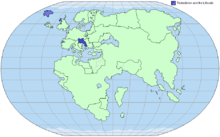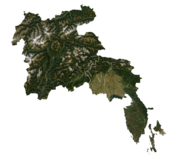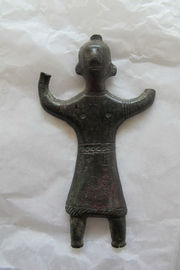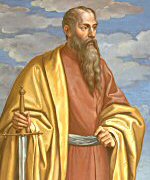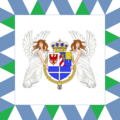Tiroladinien and the Litorale
| This page is a work in progress by its author(s) and should not be considered final. |
| Rënies Unii de Tiroladinia y dla Litorale (Federated Kingdoms of Tiroladinien and the Litorale) Tiroladinia y dla Litorale (Tiroladinien and the Litorale) |
|||||
|---|---|---|---|---|---|
|
|||||
| Motto: "A piza de crëp jì dal mer" "From the peak of the mountain to the sea" |
|||||
| Anthem: "Libera et Impera" | |||||
Position of Tiroladinien and the Litorale in OWU
|
|||||
| Region | Old World Union | ||||
| Capital and largest city | Bulsan | ||||
| Official languages | Ladin | ||||
| Recognised national languages | Italian, Slovenian, Ta'agra, Fiordlandic | ||||
| Demonym | Tiroladino-Litoralian | ||||
| Government | Federal Constitutional Monarchy | ||||
| - | King | Meinhard II | |||
| - | Prime Ministeress | Tamara Batisti | |||
| Legislature | Coronal Council and National Council (Bicameral) | ||||
| History | |||||
| - | Founding | between 690 and 900 A.D. (Tiroladinien), 1044 A.D.(Litorale) | |||
| - | Unification | 1360 A.D. | |||
| - | Federalization | February 14th 1893 A.D. | |||
| Currency | Tiroladino-Litoralian Sigmundtaler (ᛊ) |
||||
| Date format | dd ˘ mm ˘ yyyy | ||||
| Drives on the | right | ||||
| ISO 3166 code | TLF | ||||
| Internet TLD | .tlf | ||||
The Federated Kingdoms of Tiroladinien and the Litorale are a country in southern central Ureupo. They border Espirius to the north and northeast, Achea and Cisalpinya to the southeast, the Adriatic Sea to the south and Flavius Odoacer to the west. They consist of the Kingdom of Tiroladinien, the Kingdom of the Litorale, the Kingdom of Eledad (as of fall 2015) and the Viceroyalties of the Fiordland, Ynys Arglidd and the Orkland Isles, which are united as the Dominion of Insules a Nord. They are member of OWU and NPOW.
Geography
Tiroladinien
The Kingdom of Tiroladinien lies in the northwestern half of the nation. It borders Espirius to the north and the east, Achea and Cisalpinya to the east, Eledad and the Litorale to the south and Flavius Odoacer to the west. It has a very mountainous landscape. It consists of three bigger landscapes: The Northland (as the name implies it lies in the northern part of the kingdom) is the biggest of the three landscapes. It roughly covers the duchies of Bulsan and Fodom, the principalities of Osfärn and Kofstin and the margraviate of Brail. It consists mainly of limestone mountains and the valleys in between. The most important river is the En River, which crosses the En Valley, with the cities of Brail, Fodom and Kofstin the main traffic points along it. To it's southwest lies an area called Upper Court, which covers the principalities of Maran and Reiva, the countiy of Gherdëina and the margraviate of Trënt. The mountains here are slate mountains and crystalline, which erode easily. Therefore, the mountains are less high. The most important river in this area is the river Adesc, which springs from the duchy of Bulsan, but grows stronger as it flows to the county of Gherdëina. The last landscape has no proper name, it consists of the duchies of Porsennú and Anpez and the grand principality of Allegh. The mountains are made up of greywacke and limestone. They are comparably high again, but towards the east, as one approaches the border to the Litorale, they slope down rapidly. This area is filled with woodlands. The only river worth mentioning is the river Isarch, which later unites with the river Adga.
Litorale
The Litorale are the kingdom in the southeast of the nation. They border Tiroladinien to the west, Eledad and the Adriatic Sea to the south and Achea and Cisalpinya to the north and east. The north and west of the Litorale are refered to as Foothills of Tiroladinien, which pretty much gives a perfect description of the area, although to it's northern does not lie Tiroladinien but Cisalpinya. The foothills cover the kingdom of Goriska and the margraviate of Bellun. To it's south lie the grand duchy of Aquile, the duchy of Videm and the county of Pordenún. These are sometimes synptic called Litorale Proper or Litoralia Magna. The landscape is filled with small hills and ideal for growing wine. Of the three, the duchy of Videm has the "greenest" landscape, as the other two are relatively barren. In this Videm is rather similar to the duchy of Gurize, the county of Trest and the margraviate of Polei (which is commonly known as "the Seagraviate"). This area is full of scrub and brushwood, but not very fertile for crops or wine. It is uncultivated land mostly. The two islands of Crücka and Creles, which are administrative part of Polei have a very distinct landscape. While they seem to be wasteland, they are actually filled with all sorts of rare plants and animals, and were as such declared a national park.
Eledad
Under construction
Population
Ethnic Groups
The main ethnic of mainland Tiroladinien and the Litorale are the Ladinians. They make up 80.5% of the population. Italians and khajiit each make up 5% of the population, while Fiordlanders and Slovenians make up 4% each. The remaining 1.5% of the population are usually counted as "other", since the include various groups, such as Acheo-Cisalpinyans, Laerians, Voldese, Karslanders, Espirusians, etc.
It can be assumed that in recent years the number of Argliddians has increased significantly dew to the aquisition of the new viceroyalty of Ynys Arglidd, but there hasn't been a new census report since then. So it can only be speculated that the number of Argliddians is about 1%.
The khajiit are a special case. Khajiit are a species of sentient bipedal cat-people. Their language is Ta'agra, which is one of the four recognizes minority languages. The first reports of Khajiit entering the country come from the high middle ages, although scientists suspect that the first Khajiit to permanently living in Tiroladinien and the Litorale already came in late antiquity or the early middle ages. To the average Tiroladino-Litoralian, the Khajiit are nothing special, as they have always been there. Only during the 1920-30's, when the country was a fascist dictatorship, the Khajiit were assaulted for not being human. As a result, Tiroladino-Litoralians are often taken aback when a person from another country wonders about them, sometimes they even get angered about it.
Gor
The Gor are a special case too, but in their case they are the subject of a bad state of affairs. The Gor are non-humans like the Khajiit. They are satyr-like beings, who have hooves for feet and goat-like legs. Also they have elongated snouts with a little human-looking mouths and long, curved horns.
They usually live together in tribes of up to 200 individuals, which are usually led by a chieftain. They used to be very war-like in the past, and often posed a threat to the cities in which the humans and khajiit lived. Nowadays however, this has long since become history. The modern Gor don't pose a threat, as they aren't technologically advanced enough. They tend to avoid the cultured areas and live in the woods.
None of them have citizenship, as the law classifies them as them as wild animals. As such, they don't have the basic rights every citizen would get. During hunting season, one can shoot them down to brag with the trophy. Female Gor are sometimes abducted and brought to gloomy brothels at the edge of the law, where they are forced to work as prostitutes. And finally, some of them are kept as exotic "pets" by rich people, but are actually slaves in their households. Slavery and forced prostitution are viewed as severe crimes by the Tiroladino-Litoralian law. But since the Gor are not classified as people (although they obviously are), all this can be done to them by law.
There are several movements in the nation that demand that all Gor (whose numbers are unknown) receive citizenship to bring an end to this scum stove. But they are kept down by conservatives and right-wingers. Queen Claudia III. openly supports the equalist-movements.
Language
Ladin is Tiroladinien's and the Litorale's official language and is spoken natively by 84.6% of the population—followed by Italian (5%), Fiordlandic (4%), Slovenian (4%) and Ta'agra (2.3%).
The official Ladin used in education, publications, announcements and websites is Ladin. Many local dialects are spoken in Tiroladinien and the Litorale, and though their base is Standard Ladin, their corresponding speakers meet certain degrees of difficulty when trying to understand each other.
According to census information there are a total of 710,926 foreign nationals living in Tiroladinien and the Litorale. Of these, the largest by far are 283,334 foreign nationals from Achea and Cisalpinya.
The languages Italian, Slovenian, Ta'agra and Fiordlandic are recognized minority languages. They have certain rights, like protection and bilingual town signs. Effectively these rights are only claimed by the Italian and Slovenian minority, since the have a closed settlement area. Fiordlandic and Ta'agra are spread across the nation. One right all the minority languages claim is to be taught at school. Most citizens have to choose one of the languages to learn as second language as soon as they attend elementary school. Most people choose Italian, Slovenian a close second. Both Fiordlandic and Ta'agra are usually only chosen by Fiordlanders or khajii.
Religion
At the end of the 20th century, about 62% of Tiroladinien's and the Litorale's population were registered as Enopontian-Catholic, while about 30% considered themselves Protestants.
2% of the population believe in the native khajiit religion, 4% believe in the traditional Fiordlandic religion. 1% follows Buddhism, 1% is classified as "other". These include in descending order: Islam, Wicca, Judaism, Atheism, Rhaetian Neo-paganism, Religio Romana, Ásatrú, Agnosticism and Hinduism. All these religions are officially recognised.
The government is secularist since the time of age of enlightenment. Although the king and his family are officially members of the Enopontian-Catholic Church, this does not reflect int he politics of the nation. All recognised religions are equally promoted in the name of culture.
The only religion that is not only not recognized (there are some of that kind) but also is even illegal is Scientology. The authorities of Tiroladinien and the Litorale have decided that Scientology is neither a religion nor does it good to society. It was decided that it should be classified as criminal, fascistoid organisation, and is therefor outlawed by the constitution.
Largest Cities
| Largest cities or towns of Tiroladinien and the Litorale Source? | |||||||||
|---|---|---|---|---|---|---|---|---|---|
| Rank | Name | Principality | Pop. | Rank | Name | Principality | Pop. | ||
 Bulsan  Fodom |
1 | Bulsan | Duchy of Bulsan | 11 | Maran | County of Maran |  Gurize  Porsennú | ||
| 2 | Fodom | Duchy of Fodom | 12 | Polei | Margraviate of Polei | ||||
| 3 | Gurize | Duchy of Gurize | 13 | Anpez | Duchy of Anpez | ||||
| 4 | Porsennú | Duchy of Porsennú | 14 | Videm | Duchy of Videm | ||||
| 5 | Aquile | Grand Duchy of Aquile | 15 | Udin | Principality of Kofstin | ||||
| 6 | Gherdëina | County of Gherdëina | 16 | Allegh | Grand Principality of Allegh | ||||
| 7 | Goriska | Kingdom of Goriska | 17 | Trënt | Margraviate of Trënt | ||||
| 8 | Pordenún | County of Pordenún | 18 | Tresta | Principality of Tresta | ||||
| 9 | Selva | County of Pordenún | 19 | Rovéig | Principality of Tresta | ||||
| 10 | Brail | Margraviate of Brail | 20 | Osfärn | Grand Duchy of Osfärn | ||||
History
Early History
The first human settlements in Tiroladinien and the Litorale are from around the 9th century before the christ. The people who came here were nomads. They however settled down here, for some reason the land must have been attractive to them. Soon they evolved into the people of the Raetians, a proto-celtic people. There are many artifacts from this time, including cheramiks, cult objects, tools, tombs of princes, rests of early buildings and even inscriptions in a rune-like script. From these and the sources of ancient Eledad we know the most about the Raetians.
The Raetians were divided into several tribes, e.g. the Breunes, the Eniates, the Venostes, the Anaunes, and others. Eledadian author Quintus of Eledad tells of a prince of the tribe of the Arusnates, whom he gives the name Oetzos. Historians belive that this figure is identical with the famous Ötzo Valthikinu, whose grave was found in a vally in the duchy of Porsennú. Qunitus tells us, that he united most Raetian tribes of Tiroladinien under his rule. This lose federation lasted for the next 200 years, with some tribes joining and others leaving again. In the end, the Raetians were conquered by the ancient Eledadians, and the romanization of Tiroladinien began. This is usually seen as the end of early history in Tiroladinien.
The Raetians of the Litorale were much more estranged, there was no man like Ötzo who united them all, and they had no high mountains shielding them from foreign influence. Some tribes sided with the Eledadians, others opposed them. The bronce weapons of the Raetians turned out no match for the iron weapons and armors of the Eledadians, and so the Litoralian Raetians were conquered and romanized much earlier.
The Raetians believed in a multitude of gods, of which the goddess Reitia and the god Lunwoz were the most important. Reitia was a mother goddess and the most worshipped throughout both Tiroladinien and the Litorale. While the moon god Lunwoz was mainly worshipped in the north and east of Tiroladinien, he was very important in all of the country as well. Other gods the Ratians believed in were Berchta, Brekka, Noreia or Stampa. Berchta and Stampa survived in folklore until today, but they're not goddesses anymore, but elf-like beings, comparable to Jack O'Green from Irish folklore or King Arthur from British. Another element of their religion was that they viewed the Tiroladinian Eagle (nowadays national animal of the country and appearing in it's coat of arms) were the reincarnations of dead heros. To kill such an eagle was a heinous crime and punished with death.
Antiquity
Antiquity was a period of romanization for both constituent countries. The cities the Eledadians built in their new provinces were mostly built on former Raetian settlements.
Although the Raetian language remained very important, the Eledadians didn't only bring their religion but their languag, Latin, as well. The modern language of Tiroladinien and the Litorale, Ladin, evolved from Latin with Raetian influences. The Eledadians also brought paved streets, aqueducts, viniculture and many other cultural goods. The Raetian identity slowly faded away and around the year 0, most Raetians considered themselves Eledadians.
Around 450 A.D. the Eledadians retreated from nowadays Tiroladinien and the Litorale to ensure the safety of their heartland. For the former Raetians harsh times began. The formerly structured and well-ordered provinces broke into lots of city states (the modern administrative divisions of Tiroladinien and the Litorale, the so called principalities origined in that time). It's safe to say, that this was the time in wich vulgar Latin finally changed into Ladin and was adopted as language by the High society.
Sometime between 690 A.D. and 710 A.D. a very important person arrived in Tiroladinien. His name was Jean, and his real historical existence is not unquestioned. Legend tells that he came from nowadays Espirius and that he became a close friend of Valthikino de Bulsan, last duke of Bulsan from the house of the same name. Valthikino, who had no children, passed the duchy on to Jean when he died. The following was most likely a process more than one ruler accomplished, but the legend tells Jean now conquered all of Tiroladinien. The task of a united Tiroladinien was finally accomplished in the 10th century. The now ruling house, the Johanningians or Jonningians were named after Jean, who is the hero of Tiroladinien's nation epos.
Middle Ages
There is no exact date to mark the start of the middle ages in Tiroladinien and the Litorale. But usually historians begin to talk about "middle ages" in the time between the year 500 and 600. This is also when the first Khajiit most likely came to the country and permanently settled down.
Because of this both Tiroladinien and the Litorale were not yet united as kingdoms during the early middle ages. As mentioned before, the unification of Tiroladinien started during the early 8th century, and is attributed to the legendary first king Jean I. It ultimately was finished in 900, add or take away ten years. Then the two margraviates of Brail and Trënt were annexed under the rule of king Húrin I. The Litorale remained divided, but there was definitely a kind of hegemony of the duchy of Gurize.
The Johanningian War
From 945 to 1035 Tiroladinien held suzerainty over southern parts of Espirius. The situation got more complicated under the reign of Húrin IV, who ascended the throne in 1002. Under his rule, the overlordship was completely lost. Some of the noble houses, led by the houses of Fodom and Gherdëina rose against Húrin. Count Albrecht I. de Gherdëina and duke Alois I. de Fodom had both been successful commanders under Húrin's father Jaques II, and both had taken a big part in the role of securing Southern Espirius. After Jaques' death, Húrin had called them both back to their principalities. Now they claimed that it was Húrin's fault that Southern Espirius was lost. The refused to call him king anymore and adressed him only as the duke of Bulsan.Nowadays known as the Johanningian War this event had great impact on Tiroladinien. The more obvious effects were a change of ruling house and a redistribution of power among the rebelling houses. But the culture of the land was strongly influenced as well.
While the war lasted almost ten years, it was steady back and forth, in which it seemed like neither the rebels nor the royalists would win. It included important battles like the Hunt of Brail or the Battle of Trënt, which were won by the rebels, or the Battle at the En and the Battle of Porsennú, which were won by the royalists. But in the end all of these battles were non-essential, as the tremendous Battle at the Adesc would either way have left no doubt about the question who won the war. The battle, that took place only six kilometres far from Bulsan, was won by the rebels. At the climax of the battle, to which both sides had led all of their troops, Count Albrecht de Gherdëina was killed by Húrin in a duel. But the rebels won nonetheless, because they managed to kill more royalists. Húrin was captured and publicly beheaded in Bulsan. Albrecht's son Laurin claimed the trone. Two other pretenders, Alois de Fodom and Jaques de Johanning, Húrin's son, were both killed. Alois was killed in a duel and Jaques was assassinated (this assassination remains a famous incident throughout the nation until today). Following this, Laurin was crowned to be Laurin from the house of Gherdëia, the first of his name, king of the Litorale, duke of Bulsan and count of Gherdëina.
From now on, house Gherdëina ruled over all of Tiroladinien. But apparently, that was not enough. In the same year, Duke Joseph III de Gurize was anointed first king of the Litorale. Laurin himself didn't try to take his throne, as Tiroladinien was tired of war and needed some time before war could be met again. But nonetheless the next three centuries were determined with a steady rivalry between the houses of Gherdëina and Gurize.
Unification and late middle ages
In summer 1360 king Meinhard I. declared war on the Litorale. He was an ambitious young man back then, and his nobles were afraid they would loose the war. King Cesare II. de Gurize of the Litorale was an experienced fighter and strategist. This played it's part in surprising all the nobles, when the first two battles close to the border were won with ease.
The war didn't last long. In autumn, before the first snow had fallen, Meinhard and his armies marched through the gates of Gurize. Meinhard beheaded Cesare and banished his family from the capital. All members of house Gurize were send into different directions, with nothing more than the clothing they wore at the time. After this incident, he ordered the archbishop of Gurize to anoint him king of the Litorale. The prelate didn't hesitate to do so. Then, Meinhard spent the winter in Gurize before returning to Bulsan. On the second of december 1360 he wrote the Silver Bull, in which he declared the thrones of Tiroladinien and the Litorale merged forever.
For the rest of his reign, Meinhard became known as a wise ruler rather than a warmonger or even tyrant. Historians nowadays believe that Meinhard could only have won this war by sheer luck. Still, Meinhard remains a war hero for the citizens of Tiroladinien and the Litorale. (Although he actually conquered the latter. In Litoralian history books you often find him with the epithet "the Conqueror".)
Meinhard I. died of grief, when his son, who was also named Meinhard, died before he could ascend the throne. Rather than him, Meinhard's grandson Joseph ascended as Joseph II. After him, his son Andreas I. "the Last Knight" ascended to the throne. He was the first king to forge canons, and use them too. Only some minor sieges in eastern Iriah, but still. He is usually seen as the last king of the middle ages. After him the renaissance started.
Renaissance
The Renaissance started with a major event of Tiroladino-Litoralian history: The War of Tulips. Andreas's I. son ascended the throne as Joseph III. in the year of 1500. He was a young aspiring monarch when he did, and he started his reign as a good one. But when he married his wife Tamara de Fodom on March 2nd 1514, most likely due to pressure from other nobles (it is suspected that House Fodom has had a leading role in this), everything changed. In the 14 years of his reign he had shown great effort, but with every year that passed, it became more obvious that he was not fit to reign. Tamara was a proud daughter of House Fodom, and she didn't want to subordinate to a weakling from House Gherdëina; she called to arms in 1516. Several high nobles followed her call, and with their armies on her side she came one day to her husband and demanded all the executive powers. Joseph refused, and thus the war broke out. Another 14 years later, after a war that had shown that Joseph III. was a terrible strategist, he admitted defeat. Tamara and he signed a document that stated, that the rank of the king and the queen of Tiroladinien and the Litorale would be on par. Some kings took that more literally than others, while others didn't enforce it and it was a simple formality. In the case of Joseph and Tamara though, it was deadly serious. Not only that, but Joseph had lost all of his power in the war, and Tamara was the de facto sole ruler of the Federal Kingdoms. (This war entered Tiroladino-Litoralian folklore in form of a story where the king and the queen of the fey are quarreling about rulership; in the end the queen wins and petrifies the king, who becomes the mountain Falzarego (literally "False King", which lies in Porsennú.) It is proven that Joseph and Tamara later had 35 children together. Another point of interest in Josephs and Tamaras reign is, that in this time, under the financial advisor Sigmund Piccolomini the currency of the country was reformed. One of the new coin denominations included the first coin to be ever called a "Sigmundtaler", in honor of Sigmund Piccolomini.
Under king Marcell II. mercantilism was introduced to Tiroladinien and the Litorale. Trade goods from all over OWU were now heavily taxed when they were introduced to the country, and goods from Ladinia itself were almost not taxed at all. Marcell, who had keend interest in economy and discovery also sent merchant ships north; they were the first mainland power to maintain regular contact to the Fiordland, and after some years they established a trade monopoly contract with Ótar Axelson Breiðuröxl, the Jarl of Firnstayn, who was speaker of the Fiordlandic Þing at the time. Also under Marcell, one of the first contracts with Ynys Arglidd was made; however unlike the Fiordland, it was not a subject to Tiroladinien and the Litorale back then.
King Norke I. was the nephew of Marcell II. and is usually regarded the last king of the Renaissance. He is known for erecting many churches in renaissance style and collecting arts and curiousities. But there is also a darker side to his reign; many medieval buildings, for example Gothic style churches, were deemed ugly by him and thus destroyed.
Modern Age
Politics
Insignia
Flag
The national- and civil flag of Tiroladinien and the Litorale is a combination of the flags of each of the two kingdoms. On the right side of the flag is the Tiroladinian part of it. The blue on the top stands for the sky, the white in the middle stands for the snow-covered mountain peaks and the green stands for the pastures. The other part of the flag belongs to the Litorale. The two blue stripes stand for the ocean, while the white sripe symbolises the course home, the sailors from the Litorale hopefully will always be able to find.
Besides this civil flag, there are also, of course, the state and war flags. The state flag conists of the civil flag with the addition of the coat of arms of Tiroladinien on the left side and the coat of arms of the Litorale on the right side. The war flag is better described as a banner, includes the coat of arms of Tiroladinien and the Litorale on the frontside and the Order of the Ouroboros on the backside.
Finally, there are also the War Ensign and the Trade Flag, which is both the Civil Ensign and the State Ensign. The Naval Ensign is basically the flag of the Litorale with the coat of arms of the Litorale on it's left side. The Trade Flag looks like the Civil Flag, but with the Order of the Ouroboros in it's center.


